Analyzing Social Inequality and Ill-Health in the Australian Context
VerifiedAdded on 2023/01/04
|12
|3635
|85
Essay
AI Summary
This essay provides a comprehensive analysis of the relationship between social inequality and ill-health in Australia. It begins by defining social inequality and exploring its various dimensions, including health, and social inequalities based on age, culture, ethnic and social background, socio-economic position, gender orientation, geographical locale, and professional competency. The paper then delves into Marxist class categories and Critical Race Theory to understand how these frameworks explain the link between inequality and poor health, focusing on the experiences of marginalized groups like Aboriginal and Torres Strait Islander peoples. The essay further examines the connection between social inequality and poor health, discussing factors such as increased exposure to risk conditions, poor access to timely services, and resource allocation issues. Finally, it presents empirical evidence, including case studies, to illustrate the impact of social disadvantage on health outcomes, with examples focusing on access to food, healthcare, and the experiences of specific communities. The paper concludes by emphasizing the need for targeted interventions to address the health disparities caused by social inequality in Australia.
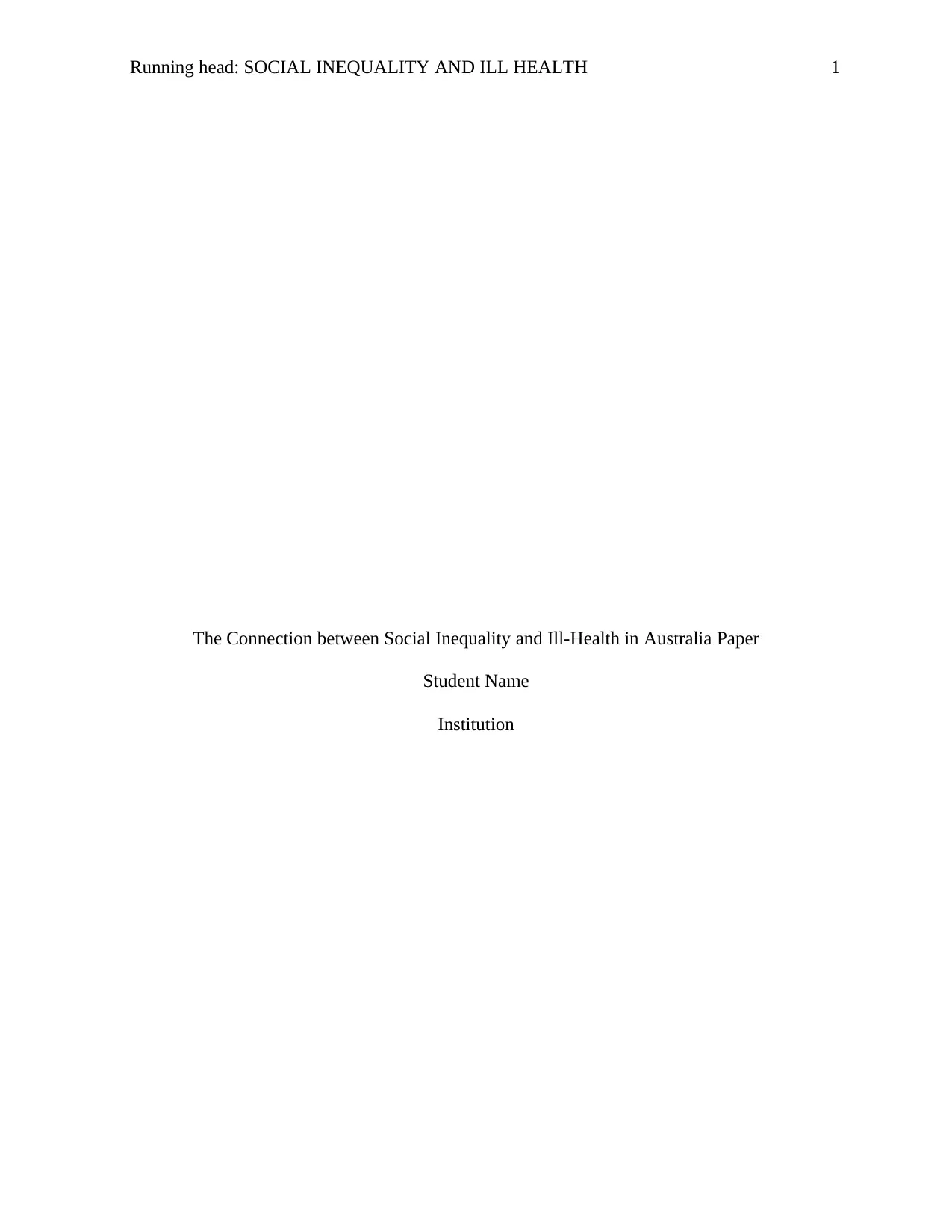
Running head: SOCIAL INEQUALITY AND ILL HEALTH 1
The Connection between Social Inequality and Ill-Health in Australia Paper
Student Name
Institution
The Connection between Social Inequality and Ill-Health in Australia Paper
Student Name
Institution
Paraphrase This Document
Need a fresh take? Get an instant paraphrase of this document with our AI Paraphraser
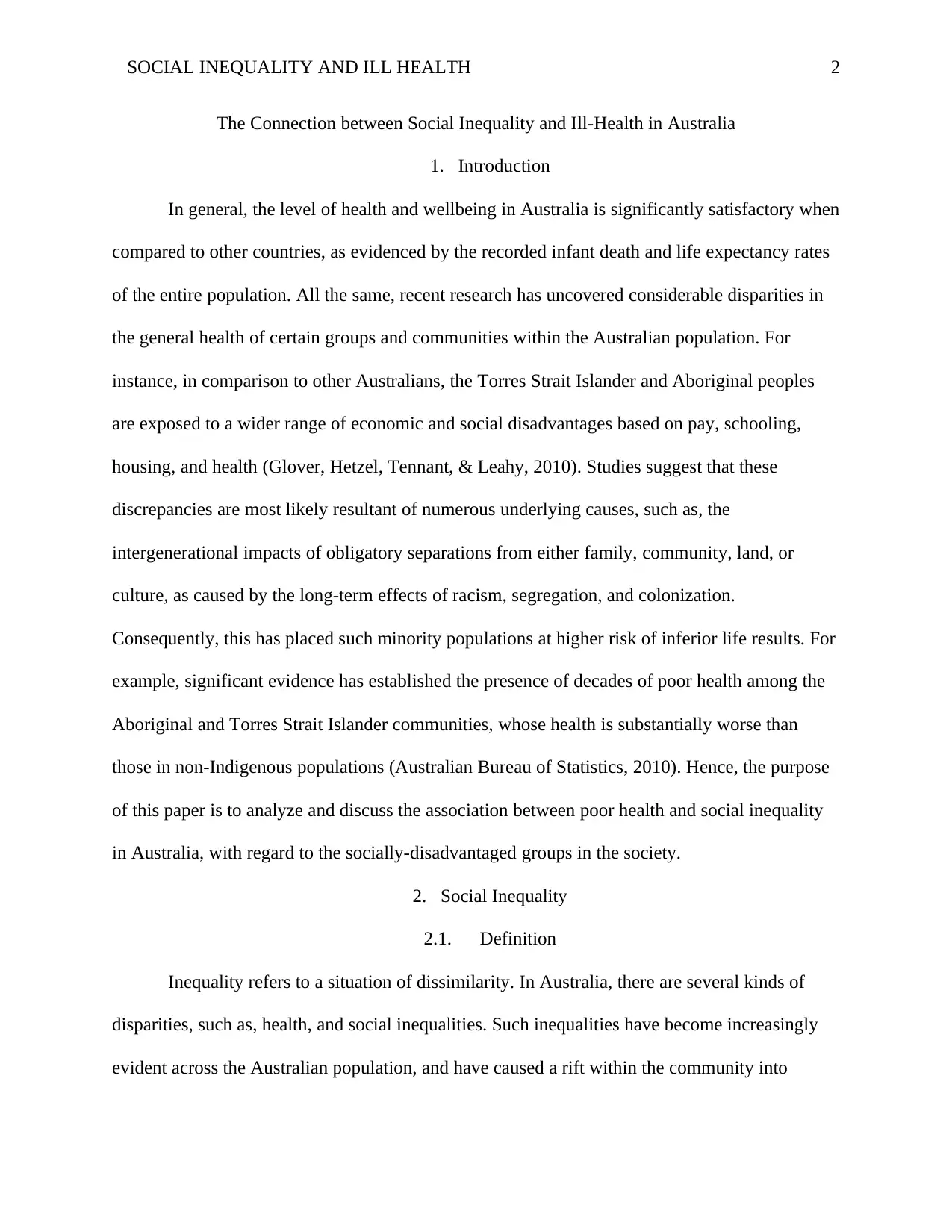
SOCIAL INEQUALITY AND ILL HEALTH 2
The Connection between Social Inequality and Ill-Health in Australia
1. Introduction
In general, the level of health and wellbeing in Australia is significantly satisfactory when
compared to other countries, as evidenced by the recorded infant death and life expectancy rates
of the entire population. All the same, recent research has uncovered considerable disparities in
the general health of certain groups and communities within the Australian population. For
instance, in comparison to other Australians, the Torres Strait Islander and Aboriginal peoples
are exposed to a wider range of economic and social disadvantages based on pay, schooling,
housing, and health (Glover, Hetzel, Tennant, & Leahy, 2010). Studies suggest that these
discrepancies are most likely resultant of numerous underlying causes, such as, the
intergenerational impacts of obligatory separations from either family, community, land, or
culture, as caused by the long-term effects of racism, segregation, and colonization.
Consequently, this has placed such minority populations at higher risk of inferior life results. For
example, significant evidence has established the presence of decades of poor health among the
Aboriginal and Torres Strait Islander communities, whose health is substantially worse than
those in non-Indigenous populations (Australian Bureau of Statistics, 2010). Hence, the purpose
of this paper is to analyze and discuss the association between poor health and social inequality
in Australia, with regard to the socially-disadvantaged groups in the society.
2. Social Inequality
2.1. Definition
Inequality refers to a situation of dissimilarity. In Australia, there are several kinds of
disparities, such as, health, and social inequalities. Such inequalities have become increasingly
evident across the Australian population, and have caused a rift within the community into
The Connection between Social Inequality and Ill-Health in Australia
1. Introduction
In general, the level of health and wellbeing in Australia is significantly satisfactory when
compared to other countries, as evidenced by the recorded infant death and life expectancy rates
of the entire population. All the same, recent research has uncovered considerable disparities in
the general health of certain groups and communities within the Australian population. For
instance, in comparison to other Australians, the Torres Strait Islander and Aboriginal peoples
are exposed to a wider range of economic and social disadvantages based on pay, schooling,
housing, and health (Glover, Hetzel, Tennant, & Leahy, 2010). Studies suggest that these
discrepancies are most likely resultant of numerous underlying causes, such as, the
intergenerational impacts of obligatory separations from either family, community, land, or
culture, as caused by the long-term effects of racism, segregation, and colonization.
Consequently, this has placed such minority populations at higher risk of inferior life results. For
example, significant evidence has established the presence of decades of poor health among the
Aboriginal and Torres Strait Islander communities, whose health is substantially worse than
those in non-Indigenous populations (Australian Bureau of Statistics, 2010). Hence, the purpose
of this paper is to analyze and discuss the association between poor health and social inequality
in Australia, with regard to the socially-disadvantaged groups in the society.
2. Social Inequality
2.1. Definition
Inequality refers to a situation of dissimilarity. In Australia, there are several kinds of
disparities, such as, health, and social inequalities. Such inequalities have become increasingly
evident across the Australian population, and have caused a rift within the community into
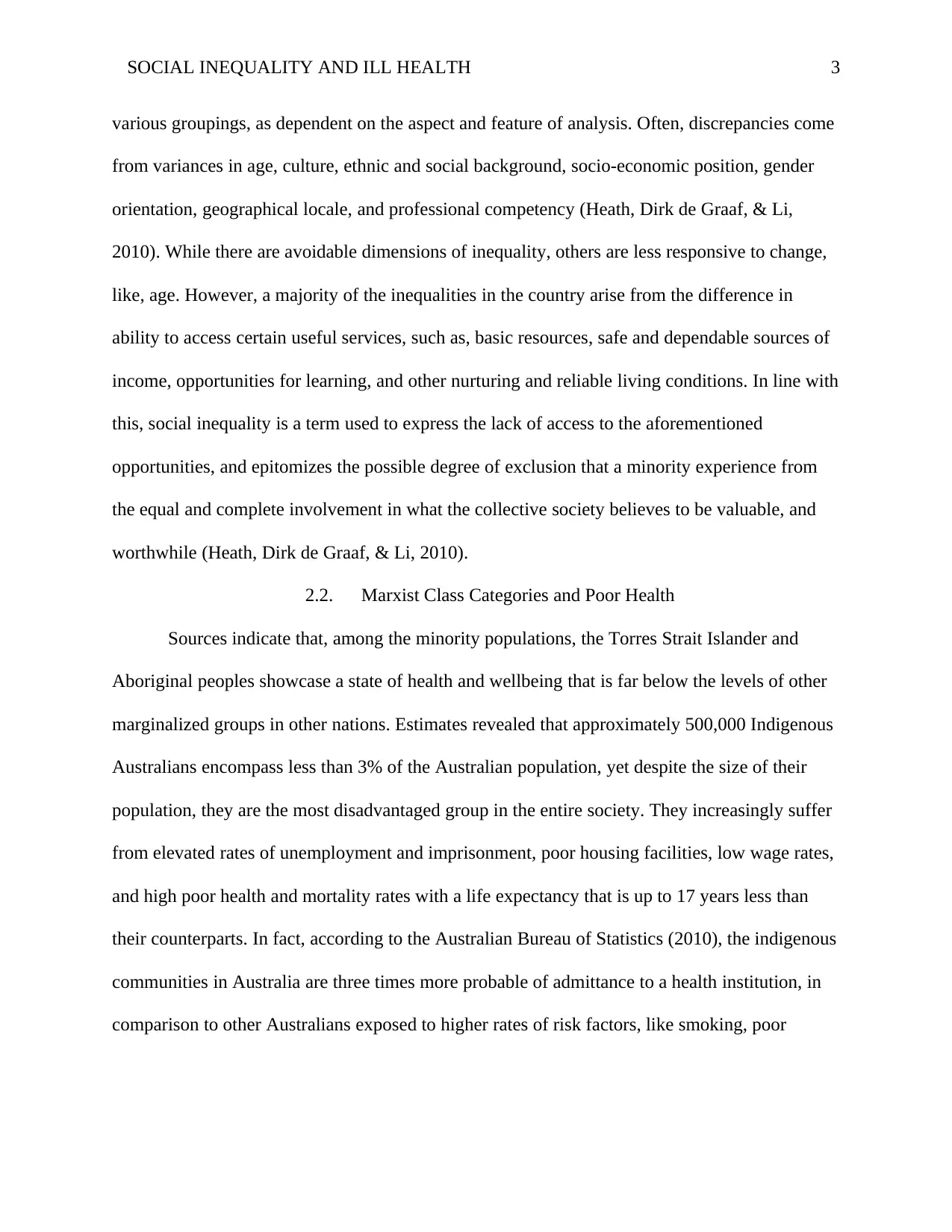
SOCIAL INEQUALITY AND ILL HEALTH 3
various groupings, as dependent on the aspect and feature of analysis. Often, discrepancies come
from variances in age, culture, ethnic and social background, socio-economic position, gender
orientation, geographical locale, and professional competency (Heath, Dirk de Graaf, & Li,
2010). While there are avoidable dimensions of inequality, others are less responsive to change,
like, age. However, a majority of the inequalities in the country arise from the difference in
ability to access certain useful services, such as, basic resources, safe and dependable sources of
income, opportunities for learning, and other nurturing and reliable living conditions. In line with
this, social inequality is a term used to express the lack of access to the aforementioned
opportunities, and epitomizes the possible degree of exclusion that a minority experience from
the equal and complete involvement in what the collective society believes to be valuable, and
worthwhile (Heath, Dirk de Graaf, & Li, 2010).
2.2. Marxist Class Categories and Poor Health
Sources indicate that, among the minority populations, the Torres Strait Islander and
Aboriginal peoples showcase a state of health and wellbeing that is far below the levels of other
marginalized groups in other nations. Estimates revealed that approximately 500,000 Indigenous
Australians encompass less than 3% of the Australian population, yet despite the size of their
population, they are the most disadvantaged group in the entire society. They increasingly suffer
from elevated rates of unemployment and imprisonment, poor housing facilities, low wage rates,
and high poor health and mortality rates with a life expectancy that is up to 17 years less than
their counterparts. In fact, according to the Australian Bureau of Statistics (2010), the indigenous
communities in Australia are three times more probable of admittance to a health institution, in
comparison to other Australians exposed to higher rates of risk factors, like smoking, poor
various groupings, as dependent on the aspect and feature of analysis. Often, discrepancies come
from variances in age, culture, ethnic and social background, socio-economic position, gender
orientation, geographical locale, and professional competency (Heath, Dirk de Graaf, & Li,
2010). While there are avoidable dimensions of inequality, others are less responsive to change,
like, age. However, a majority of the inequalities in the country arise from the difference in
ability to access certain useful services, such as, basic resources, safe and dependable sources of
income, opportunities for learning, and other nurturing and reliable living conditions. In line with
this, social inequality is a term used to express the lack of access to the aforementioned
opportunities, and epitomizes the possible degree of exclusion that a minority experience from
the equal and complete involvement in what the collective society believes to be valuable, and
worthwhile (Heath, Dirk de Graaf, & Li, 2010).
2.2. Marxist Class Categories and Poor Health
Sources indicate that, among the minority populations, the Torres Strait Islander and
Aboriginal peoples showcase a state of health and wellbeing that is far below the levels of other
marginalized groups in other nations. Estimates revealed that approximately 500,000 Indigenous
Australians encompass less than 3% of the Australian population, yet despite the size of their
population, they are the most disadvantaged group in the entire society. They increasingly suffer
from elevated rates of unemployment and imprisonment, poor housing facilities, low wage rates,
and high poor health and mortality rates with a life expectancy that is up to 17 years less than
their counterparts. In fact, according to the Australian Bureau of Statistics (2010), the indigenous
communities in Australia are three times more probable of admittance to a health institution, in
comparison to other Australians exposed to higher rates of risk factors, like smoking, poor
⊘ This is a preview!⊘
Do you want full access?
Subscribe today to unlock all pages.

Trusted by 1+ million students worldwide
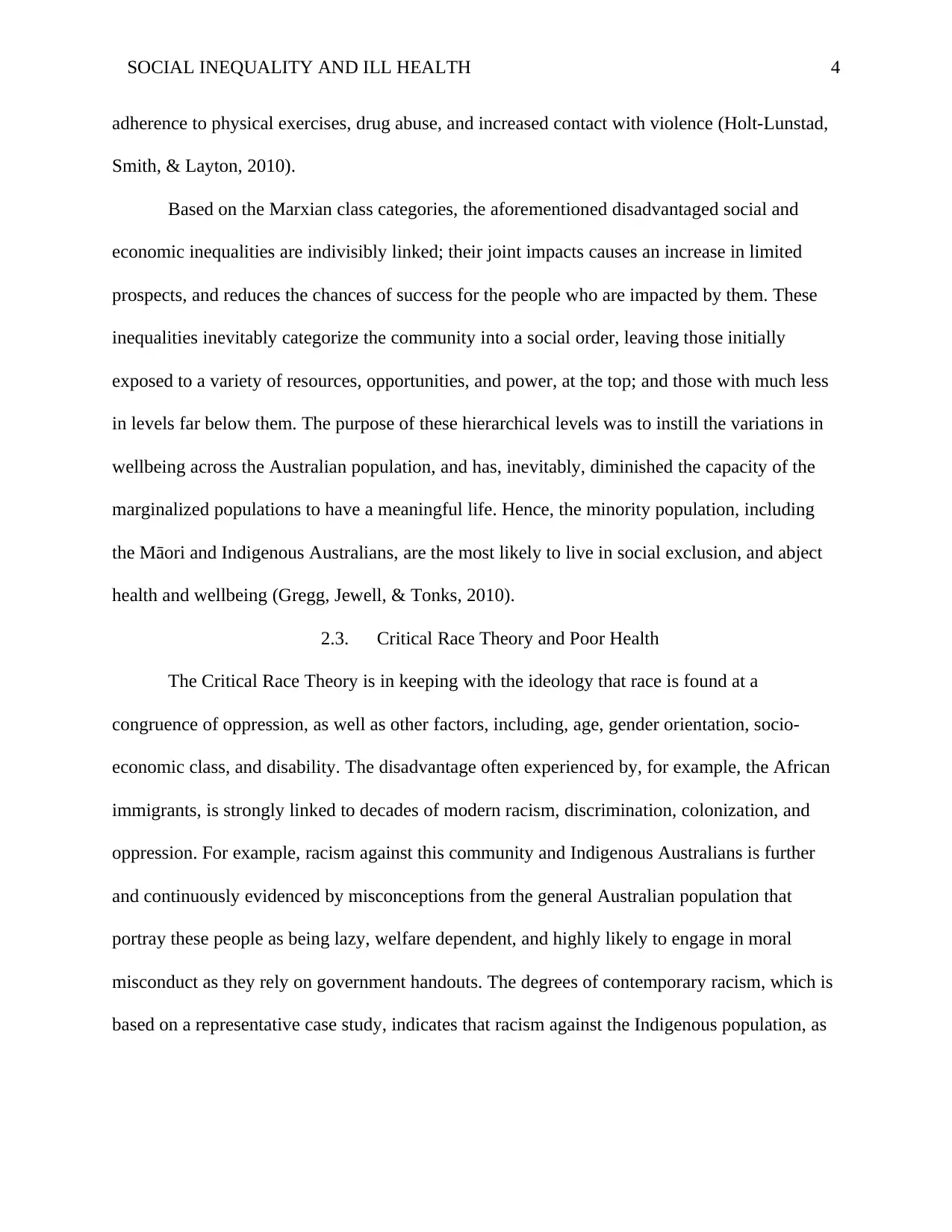
SOCIAL INEQUALITY AND ILL HEALTH 4
adherence to physical exercises, drug abuse, and increased contact with violence (Holt-Lunstad,
Smith, & Layton, 2010).
Based on the Marxian class categories, the aforementioned disadvantaged social and
economic inequalities are indivisibly linked; their joint impacts causes an increase in limited
prospects, and reduces the chances of success for the people who are impacted by them. These
inequalities inevitably categorize the community into a social order, leaving those initially
exposed to a variety of resources, opportunities, and power, at the top; and those with much less
in levels far below them. The purpose of these hierarchical levels was to instill the variations in
wellbeing across the Australian population, and has, inevitably, diminished the capacity of the
marginalized populations to have a meaningful life. Hence, the minority population, including
the Māori and Indigenous Australians, are the most likely to live in social exclusion, and abject
health and wellbeing (Gregg, Jewell, & Tonks, 2010).
2.3. Critical Race Theory and Poor Health
The Critical Race Theory is in keeping with the ideology that race is found at a
congruence of oppression, as well as other factors, including, age, gender orientation, socio-
economic class, and disability. The disadvantage often experienced by, for example, the African
immigrants, is strongly linked to decades of modern racism, discrimination, colonization, and
oppression. For example, racism against this community and Indigenous Australians is further
and continuously evidenced by misconceptions from the general Australian population that
portray these people as being lazy, welfare dependent, and highly likely to engage in moral
misconduct as they rely on government handouts. The degrees of contemporary racism, which is
based on a representative case study, indicates that racism against the Indigenous population, as
adherence to physical exercises, drug abuse, and increased contact with violence (Holt-Lunstad,
Smith, & Layton, 2010).
Based on the Marxian class categories, the aforementioned disadvantaged social and
economic inequalities are indivisibly linked; their joint impacts causes an increase in limited
prospects, and reduces the chances of success for the people who are impacted by them. These
inequalities inevitably categorize the community into a social order, leaving those initially
exposed to a variety of resources, opportunities, and power, at the top; and those with much less
in levels far below them. The purpose of these hierarchical levels was to instill the variations in
wellbeing across the Australian population, and has, inevitably, diminished the capacity of the
marginalized populations to have a meaningful life. Hence, the minority population, including
the Māori and Indigenous Australians, are the most likely to live in social exclusion, and abject
health and wellbeing (Gregg, Jewell, & Tonks, 2010).
2.3. Critical Race Theory and Poor Health
The Critical Race Theory is in keeping with the ideology that race is found at a
congruence of oppression, as well as other factors, including, age, gender orientation, socio-
economic class, and disability. The disadvantage often experienced by, for example, the African
immigrants, is strongly linked to decades of modern racism, discrimination, colonization, and
oppression. For example, racism against this community and Indigenous Australians is further
and continuously evidenced by misconceptions from the general Australian population that
portray these people as being lazy, welfare dependent, and highly likely to engage in moral
misconduct as they rely on government handouts. The degrees of contemporary racism, which is
based on a representative case study, indicates that racism against the Indigenous population, as
Paraphrase This Document
Need a fresh take? Get an instant paraphrase of this document with our AI Paraphraser
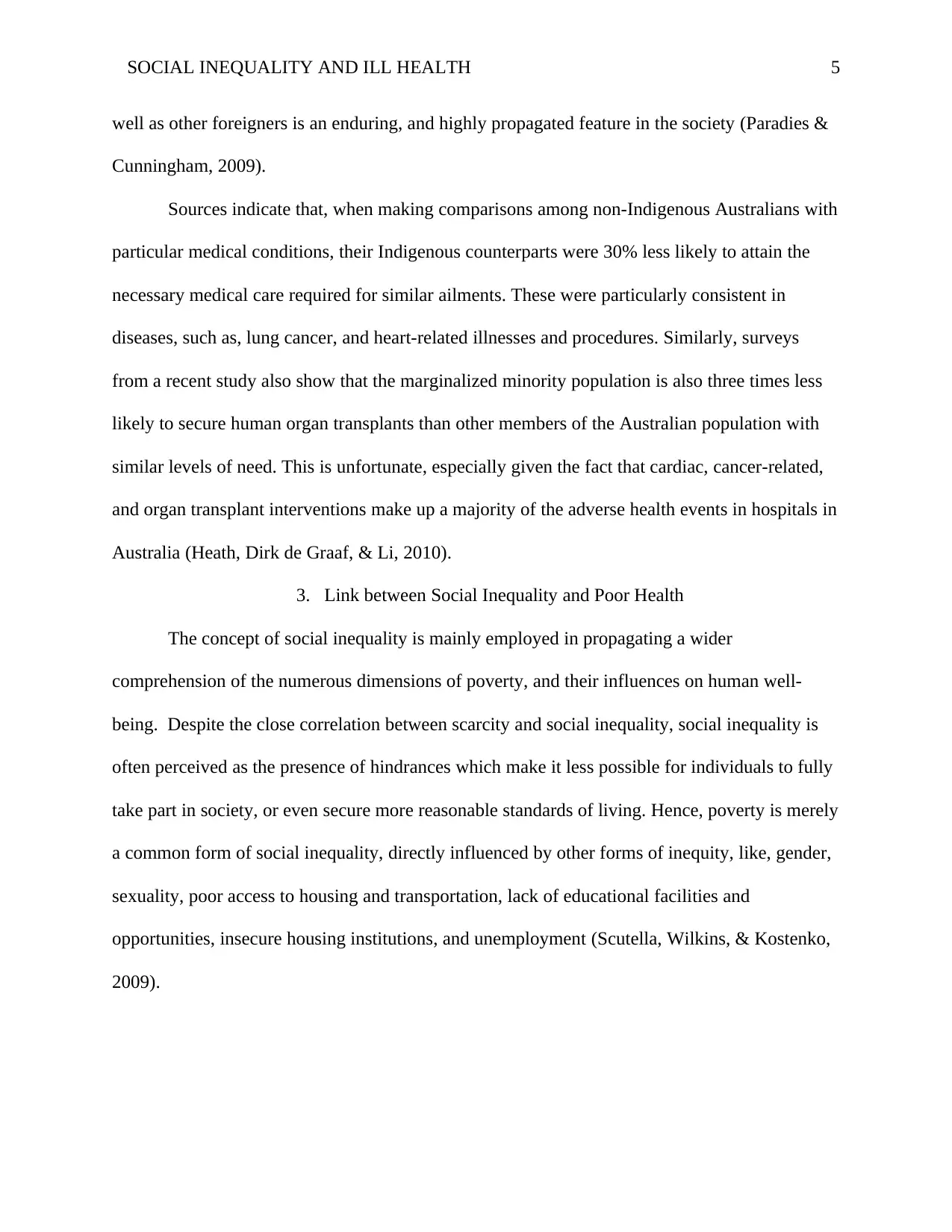
SOCIAL INEQUALITY AND ILL HEALTH 5
well as other foreigners is an enduring, and highly propagated feature in the society (Paradies &
Cunningham, 2009).
Sources indicate that, when making comparisons among non-Indigenous Australians with
particular medical conditions, their Indigenous counterparts were 30% less likely to attain the
necessary medical care required for similar ailments. These were particularly consistent in
diseases, such as, lung cancer, and heart-related illnesses and procedures. Similarly, surveys
from a recent study also show that the marginalized minority population is also three times less
likely to secure human organ transplants than other members of the Australian population with
similar levels of need. This is unfortunate, especially given the fact that cardiac, cancer-related,
and organ transplant interventions make up a majority of the adverse health events in hospitals in
Australia (Heath, Dirk de Graaf, & Li, 2010).
3. Link between Social Inequality and Poor Health
The concept of social inequality is mainly employed in propagating a wider
comprehension of the numerous dimensions of poverty, and their influences on human well-
being. Despite the close correlation between scarcity and social inequality, social inequality is
often perceived as the presence of hindrances which make it less possible for individuals to fully
take part in society, or even secure more reasonable standards of living. Hence, poverty is merely
a common form of social inequality, directly influenced by other forms of inequity, like, gender,
sexuality, poor access to housing and transportation, lack of educational facilities and
opportunities, insecure housing institutions, and unemployment (Scutella, Wilkins, & Kostenko,
2009).
well as other foreigners is an enduring, and highly propagated feature in the society (Paradies &
Cunningham, 2009).
Sources indicate that, when making comparisons among non-Indigenous Australians with
particular medical conditions, their Indigenous counterparts were 30% less likely to attain the
necessary medical care required for similar ailments. These were particularly consistent in
diseases, such as, lung cancer, and heart-related illnesses and procedures. Similarly, surveys
from a recent study also show that the marginalized minority population is also three times less
likely to secure human organ transplants than other members of the Australian population with
similar levels of need. This is unfortunate, especially given the fact that cardiac, cancer-related,
and organ transplant interventions make up a majority of the adverse health events in hospitals in
Australia (Heath, Dirk de Graaf, & Li, 2010).
3. Link between Social Inequality and Poor Health
The concept of social inequality is mainly employed in propagating a wider
comprehension of the numerous dimensions of poverty, and their influences on human well-
being. Despite the close correlation between scarcity and social inequality, social inequality is
often perceived as the presence of hindrances which make it less possible for individuals to fully
take part in society, or even secure more reasonable standards of living. Hence, poverty is merely
a common form of social inequality, directly influenced by other forms of inequity, like, gender,
sexuality, poor access to housing and transportation, lack of educational facilities and
opportunities, insecure housing institutions, and unemployment (Scutella, Wilkins, & Kostenko,
2009).
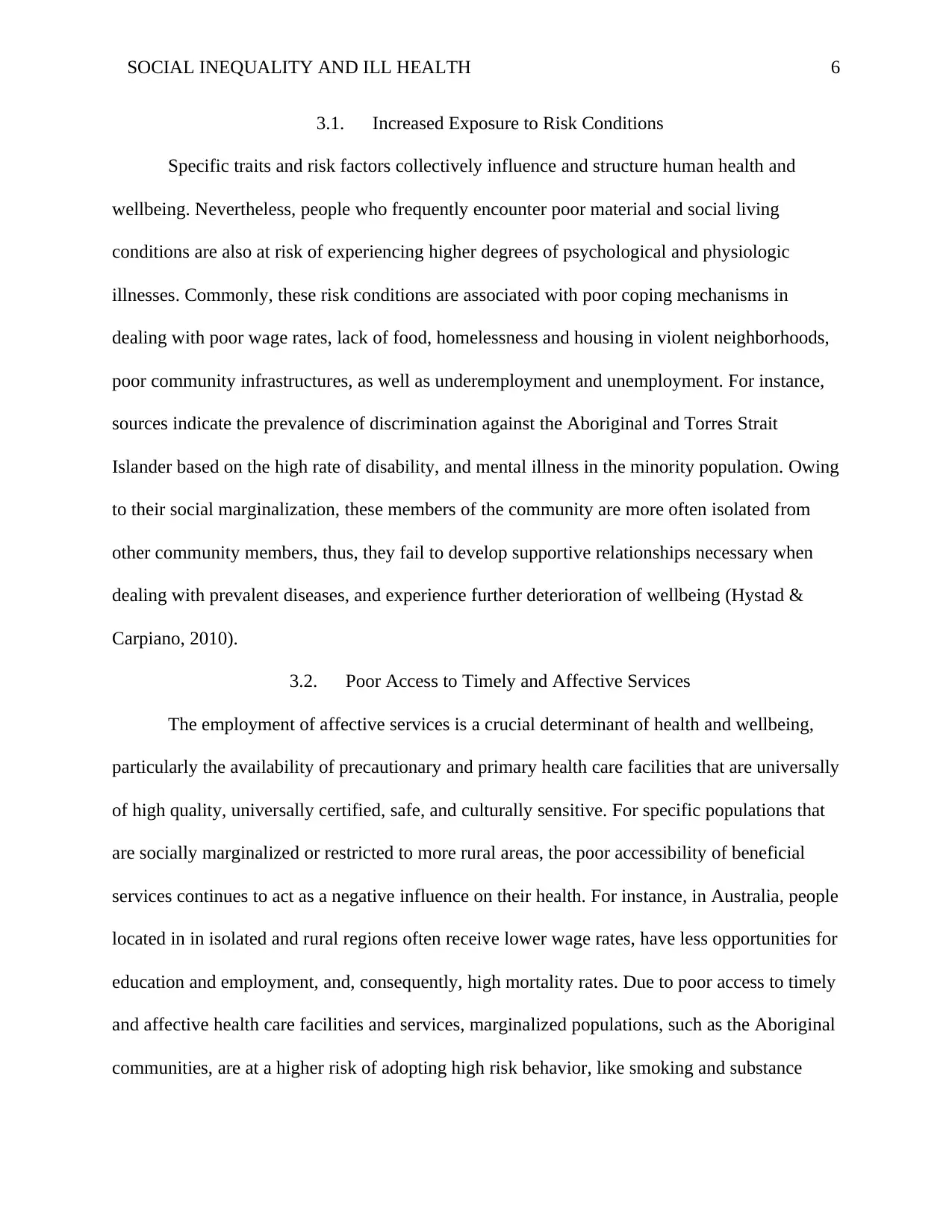
SOCIAL INEQUALITY AND ILL HEALTH 6
3.1. Increased Exposure to Risk Conditions
Specific traits and risk factors collectively influence and structure human health and
wellbeing. Nevertheless, people who frequently encounter poor material and social living
conditions are also at risk of experiencing higher degrees of psychological and physiologic
illnesses. Commonly, these risk conditions are associated with poor coping mechanisms in
dealing with poor wage rates, lack of food, homelessness and housing in violent neighborhoods,
poor community infrastructures, as well as underemployment and unemployment. For instance,
sources indicate the prevalence of discrimination against the Aboriginal and Torres Strait
Islander based on the high rate of disability, and mental illness in the minority population. Owing
to their social marginalization, these members of the community are more often isolated from
other community members, thus, they fail to develop supportive relationships necessary when
dealing with prevalent diseases, and experience further deterioration of wellbeing (Hystad &
Carpiano, 2010).
3.2. Poor Access to Timely and Affective Services
The employment of affective services is a crucial determinant of health and wellbeing,
particularly the availability of precautionary and primary health care facilities that are universally
of high quality, universally certified, safe, and culturally sensitive. For specific populations that
are socially marginalized or restricted to more rural areas, the poor accessibility of beneficial
services continues to act as a negative influence on their health. For instance, in Australia, people
located in in isolated and rural regions often receive lower wage rates, have less opportunities for
education and employment, and, consequently, high mortality rates. Due to poor access to timely
and affective health care facilities and services, marginalized populations, such as the Aboriginal
communities, are at a higher risk of adopting high risk behavior, like smoking and substance
3.1. Increased Exposure to Risk Conditions
Specific traits and risk factors collectively influence and structure human health and
wellbeing. Nevertheless, people who frequently encounter poor material and social living
conditions are also at risk of experiencing higher degrees of psychological and physiologic
illnesses. Commonly, these risk conditions are associated with poor coping mechanisms in
dealing with poor wage rates, lack of food, homelessness and housing in violent neighborhoods,
poor community infrastructures, as well as underemployment and unemployment. For instance,
sources indicate the prevalence of discrimination against the Aboriginal and Torres Strait
Islander based on the high rate of disability, and mental illness in the minority population. Owing
to their social marginalization, these members of the community are more often isolated from
other community members, thus, they fail to develop supportive relationships necessary when
dealing with prevalent diseases, and experience further deterioration of wellbeing (Hystad &
Carpiano, 2010).
3.2. Poor Access to Timely and Affective Services
The employment of affective services is a crucial determinant of health and wellbeing,
particularly the availability of precautionary and primary health care facilities that are universally
of high quality, universally certified, safe, and culturally sensitive. For specific populations that
are socially marginalized or restricted to more rural areas, the poor accessibility of beneficial
services continues to act as a negative influence on their health. For instance, in Australia, people
located in in isolated and rural regions often receive lower wage rates, have less opportunities for
education and employment, and, consequently, high mortality rates. Due to poor access to timely
and affective health care facilities and services, marginalized populations, such as the Aboriginal
communities, are at a higher risk of adopting high risk behavior, like smoking and substance
⊘ This is a preview!⊘
Do you want full access?
Subscribe today to unlock all pages.

Trusted by 1+ million students worldwide
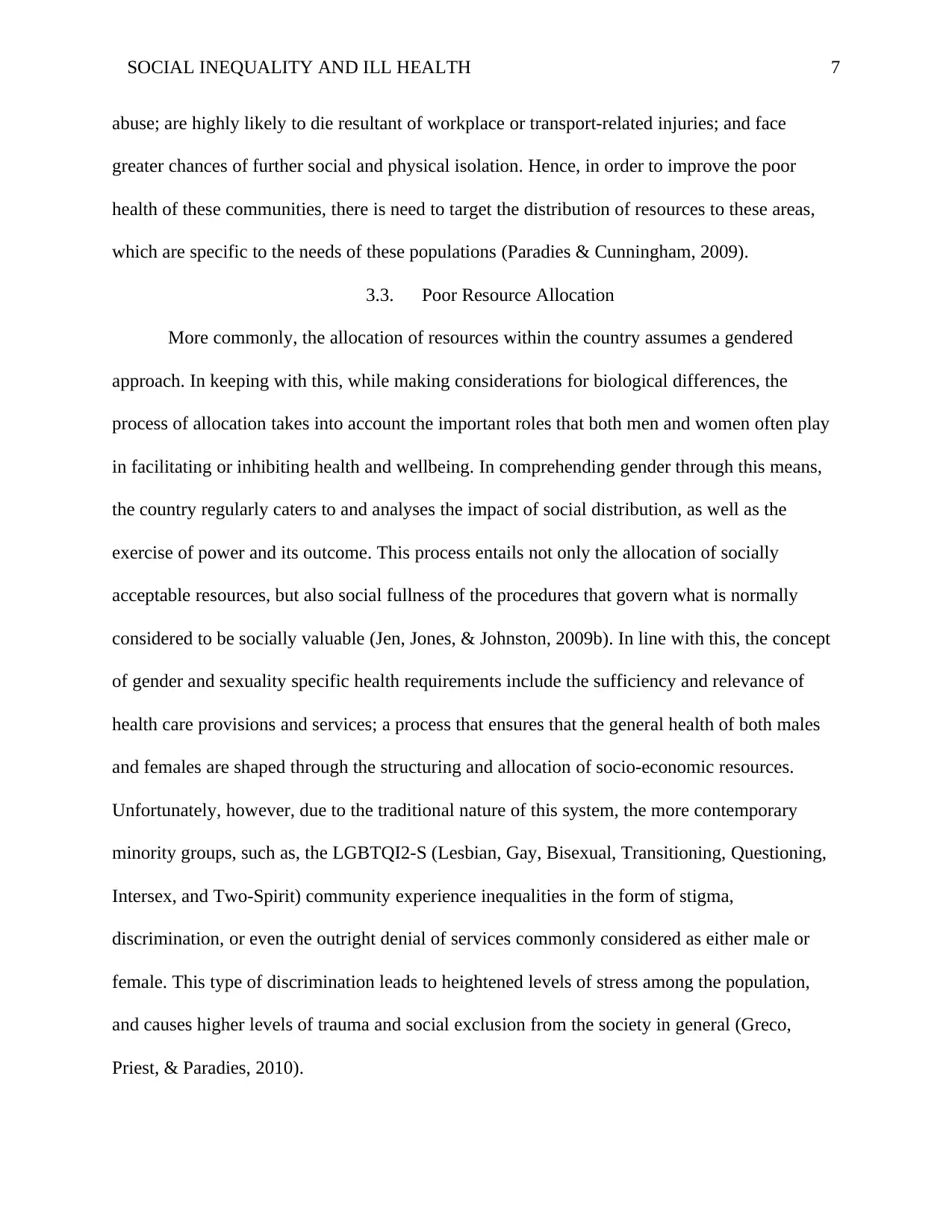
SOCIAL INEQUALITY AND ILL HEALTH 7
abuse; are highly likely to die resultant of workplace or transport-related injuries; and face
greater chances of further social and physical isolation. Hence, in order to improve the poor
health of these communities, there is need to target the distribution of resources to these areas,
which are specific to the needs of these populations (Paradies & Cunningham, 2009).
3.3. Poor Resource Allocation
More commonly, the allocation of resources within the country assumes a gendered
approach. In keeping with this, while making considerations for biological differences, the
process of allocation takes into account the important roles that both men and women often play
in facilitating or inhibiting health and wellbeing. In comprehending gender through this means,
the country regularly caters to and analyses the impact of social distribution, as well as the
exercise of power and its outcome. This process entails not only the allocation of socially
acceptable resources, but also social fullness of the procedures that govern what is normally
considered to be socially valuable (Jen, Jones, & Johnston, 2009b). In line with this, the concept
of gender and sexuality specific health requirements include the sufficiency and relevance of
health care provisions and services; a process that ensures that the general health of both males
and females are shaped through the structuring and allocation of socio-economic resources.
Unfortunately, however, due to the traditional nature of this system, the more contemporary
minority groups, such as, the LGBTQI2-S (Lesbian, Gay, Bisexual, Transitioning, Questioning,
Intersex, and Two-Spirit) community experience inequalities in the form of stigma,
discrimination, or even the outright denial of services commonly considered as either male or
female. This type of discrimination leads to heightened levels of stress among the population,
and causes higher levels of trauma and social exclusion from the society in general (Greco,
Priest, & Paradies, 2010).
abuse; are highly likely to die resultant of workplace or transport-related injuries; and face
greater chances of further social and physical isolation. Hence, in order to improve the poor
health of these communities, there is need to target the distribution of resources to these areas,
which are specific to the needs of these populations (Paradies & Cunningham, 2009).
3.3. Poor Resource Allocation
More commonly, the allocation of resources within the country assumes a gendered
approach. In keeping with this, while making considerations for biological differences, the
process of allocation takes into account the important roles that both men and women often play
in facilitating or inhibiting health and wellbeing. In comprehending gender through this means,
the country regularly caters to and analyses the impact of social distribution, as well as the
exercise of power and its outcome. This process entails not only the allocation of socially
acceptable resources, but also social fullness of the procedures that govern what is normally
considered to be socially valuable (Jen, Jones, & Johnston, 2009b). In line with this, the concept
of gender and sexuality specific health requirements include the sufficiency and relevance of
health care provisions and services; a process that ensures that the general health of both males
and females are shaped through the structuring and allocation of socio-economic resources.
Unfortunately, however, due to the traditional nature of this system, the more contemporary
minority groups, such as, the LGBTQI2-S (Lesbian, Gay, Bisexual, Transitioning, Questioning,
Intersex, and Two-Spirit) community experience inequalities in the form of stigma,
discrimination, or even the outright denial of services commonly considered as either male or
female. This type of discrimination leads to heightened levels of stress among the population,
and causes higher levels of trauma and social exclusion from the society in general (Greco,
Priest, & Paradies, 2010).
Paraphrase This Document
Need a fresh take? Get an instant paraphrase of this document with our AI Paraphraser
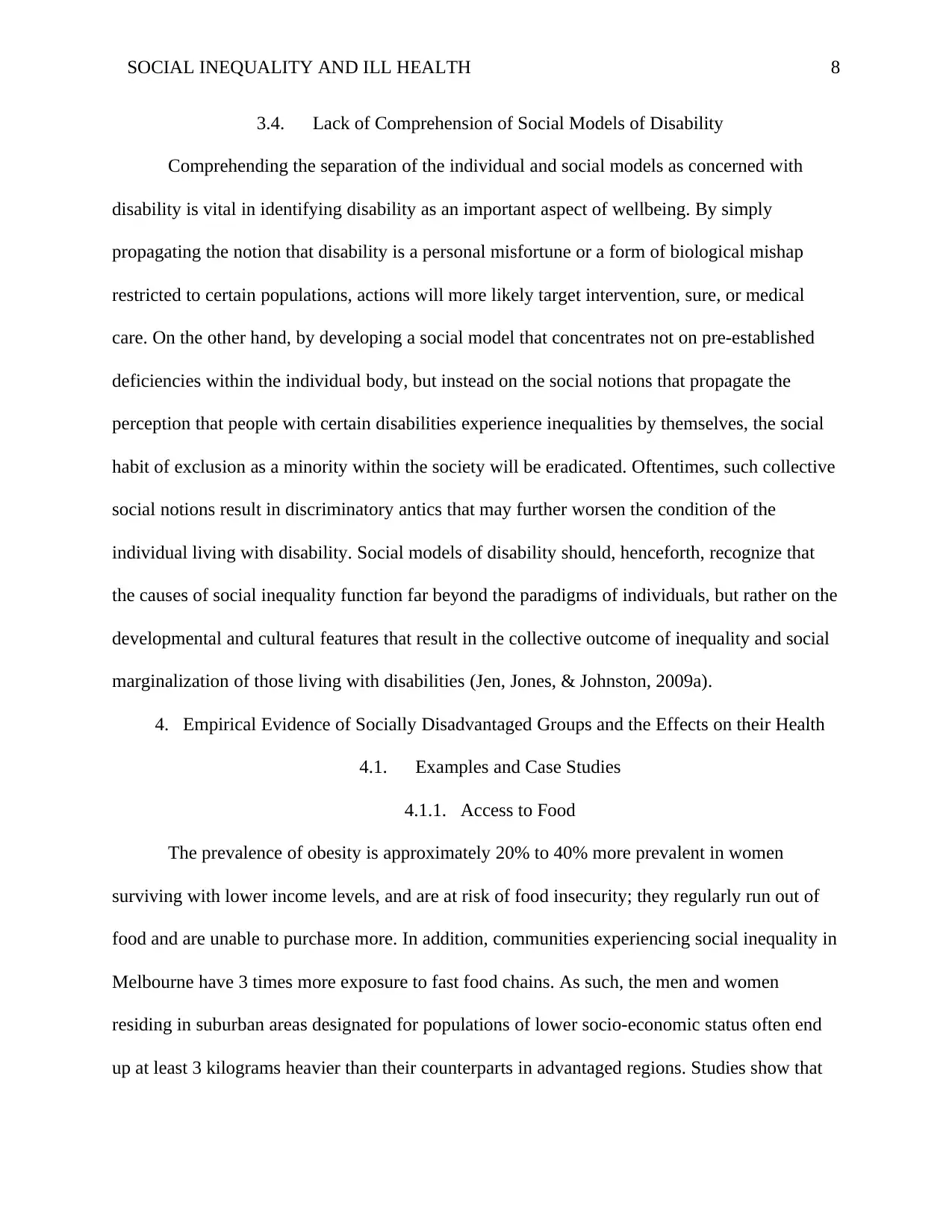
SOCIAL INEQUALITY AND ILL HEALTH 8
3.4. Lack of Comprehension of Social Models of Disability
Comprehending the separation of the individual and social models as concerned with
disability is vital in identifying disability as an important aspect of wellbeing. By simply
propagating the notion that disability is a personal misfortune or a form of biological mishap
restricted to certain populations, actions will more likely target intervention, sure, or medical
care. On the other hand, by developing a social model that concentrates not on pre-established
deficiencies within the individual body, but instead on the social notions that propagate the
perception that people with certain disabilities experience inequalities by themselves, the social
habit of exclusion as a minority within the society will be eradicated. Oftentimes, such collective
social notions result in discriminatory antics that may further worsen the condition of the
individual living with disability. Social models of disability should, henceforth, recognize that
the causes of social inequality function far beyond the paradigms of individuals, but rather on the
developmental and cultural features that result in the collective outcome of inequality and social
marginalization of those living with disabilities (Jen, Jones, & Johnston, 2009a).
4. Empirical Evidence of Socially Disadvantaged Groups and the Effects on their Health
4.1. Examples and Case Studies
4.1.1. Access to Food
The prevalence of obesity is approximately 20% to 40% more prevalent in women
surviving with lower income levels, and are at risk of food insecurity; they regularly run out of
food and are unable to purchase more. In addition, communities experiencing social inequality in
Melbourne have 3 times more exposure to fast food chains. As such, the men and women
residing in suburban areas designated for populations of lower socio-economic status often end
up at least 3 kilograms heavier than their counterparts in advantaged regions. Studies show that
3.4. Lack of Comprehension of Social Models of Disability
Comprehending the separation of the individual and social models as concerned with
disability is vital in identifying disability as an important aspect of wellbeing. By simply
propagating the notion that disability is a personal misfortune or a form of biological mishap
restricted to certain populations, actions will more likely target intervention, sure, or medical
care. On the other hand, by developing a social model that concentrates not on pre-established
deficiencies within the individual body, but instead on the social notions that propagate the
perception that people with certain disabilities experience inequalities by themselves, the social
habit of exclusion as a minority within the society will be eradicated. Oftentimes, such collective
social notions result in discriminatory antics that may further worsen the condition of the
individual living with disability. Social models of disability should, henceforth, recognize that
the causes of social inequality function far beyond the paradigms of individuals, but rather on the
developmental and cultural features that result in the collective outcome of inequality and social
marginalization of those living with disabilities (Jen, Jones, & Johnston, 2009a).
4. Empirical Evidence of Socially Disadvantaged Groups and the Effects on their Health
4.1. Examples and Case Studies
4.1.1. Access to Food
The prevalence of obesity is approximately 20% to 40% more prevalent in women
surviving with lower income levels, and are at risk of food insecurity; they regularly run out of
food and are unable to purchase more. In addition, communities experiencing social inequality in
Melbourne have 3 times more exposure to fast food chains. As such, the men and women
residing in suburban areas designated for populations of lower socio-economic status often end
up at least 3 kilograms heavier than their counterparts in advantaged regions. Studies show that
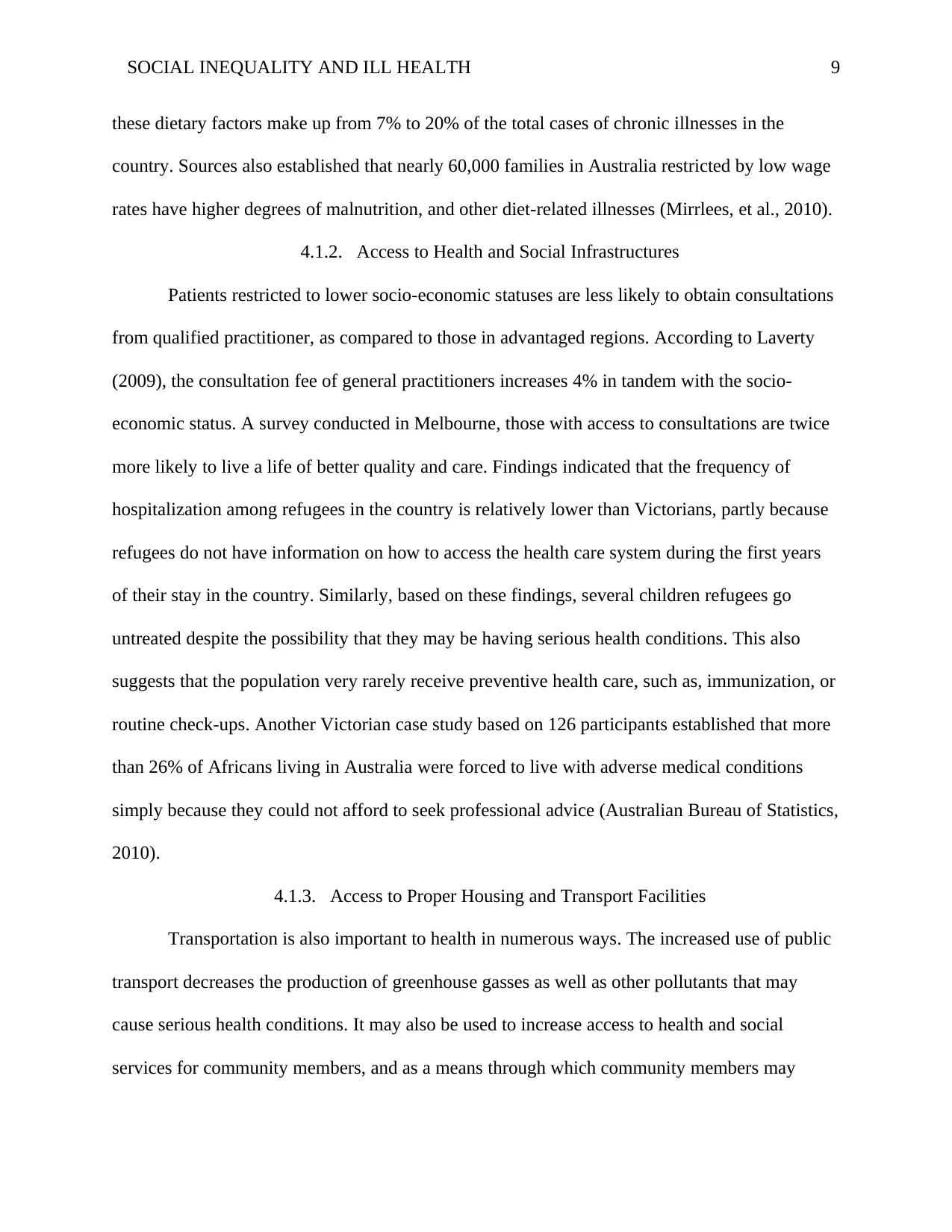
SOCIAL INEQUALITY AND ILL HEALTH 9
these dietary factors make up from 7% to 20% of the total cases of chronic illnesses in the
country. Sources also established that nearly 60,000 families in Australia restricted by low wage
rates have higher degrees of malnutrition, and other diet-related illnesses (Mirrlees, et al., 2010).
4.1.2. Access to Health and Social Infrastructures
Patients restricted to lower socio-economic statuses are less likely to obtain consultations
from qualified practitioner, as compared to those in advantaged regions. According to Laverty
(2009), the consultation fee of general practitioners increases 4% in tandem with the socio-
economic status. A survey conducted in Melbourne, those with access to consultations are twice
more likely to live a life of better quality and care. Findings indicated that the frequency of
hospitalization among refugees in the country is relatively lower than Victorians, partly because
refugees do not have information on how to access the health care system during the first years
of their stay in the country. Similarly, based on these findings, several children refugees go
untreated despite the possibility that they may be having serious health conditions. This also
suggests that the population very rarely receive preventive health care, such as, immunization, or
routine check-ups. Another Victorian case study based on 126 participants established that more
than 26% of Africans living in Australia were forced to live with adverse medical conditions
simply because they could not afford to seek professional advice (Australian Bureau of Statistics,
2010).
4.1.3. Access to Proper Housing and Transport Facilities
Transportation is also important to health in numerous ways. The increased use of public
transport decreases the production of greenhouse gasses as well as other pollutants that may
cause serious health conditions. It may also be used to increase access to health and social
services for community members, and as a means through which community members may
these dietary factors make up from 7% to 20% of the total cases of chronic illnesses in the
country. Sources also established that nearly 60,000 families in Australia restricted by low wage
rates have higher degrees of malnutrition, and other diet-related illnesses (Mirrlees, et al., 2010).
4.1.2. Access to Health and Social Infrastructures
Patients restricted to lower socio-economic statuses are less likely to obtain consultations
from qualified practitioner, as compared to those in advantaged regions. According to Laverty
(2009), the consultation fee of general practitioners increases 4% in tandem with the socio-
economic status. A survey conducted in Melbourne, those with access to consultations are twice
more likely to live a life of better quality and care. Findings indicated that the frequency of
hospitalization among refugees in the country is relatively lower than Victorians, partly because
refugees do not have information on how to access the health care system during the first years
of their stay in the country. Similarly, based on these findings, several children refugees go
untreated despite the possibility that they may be having serious health conditions. This also
suggests that the population very rarely receive preventive health care, such as, immunization, or
routine check-ups. Another Victorian case study based on 126 participants established that more
than 26% of Africans living in Australia were forced to live with adverse medical conditions
simply because they could not afford to seek professional advice (Australian Bureau of Statistics,
2010).
4.1.3. Access to Proper Housing and Transport Facilities
Transportation is also important to health in numerous ways. The increased use of public
transport decreases the production of greenhouse gasses as well as other pollutants that may
cause serious health conditions. It may also be used to increase access to health and social
services for community members, and as a means through which community members may
⊘ This is a preview!⊘
Do you want full access?
Subscribe today to unlock all pages.

Trusted by 1+ million students worldwide
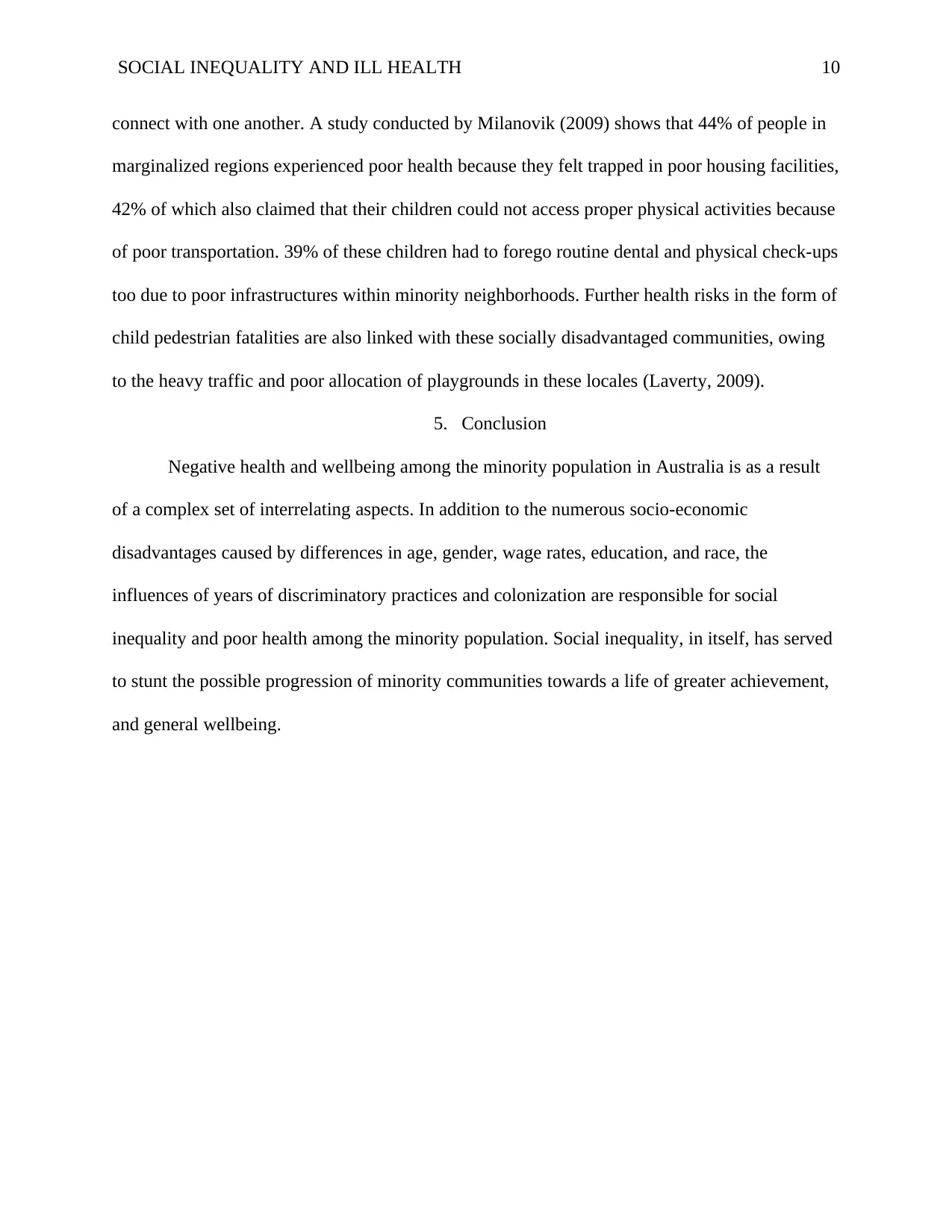
SOCIAL INEQUALITY AND ILL HEALTH 10
connect with one another. A study conducted by Milanovik (2009) shows that 44% of people in
marginalized regions experienced poor health because they felt trapped in poor housing facilities,
42% of which also claimed that their children could not access proper physical activities because
of poor transportation. 39% of these children had to forego routine dental and physical check-ups
too due to poor infrastructures within minority neighborhoods. Further health risks in the form of
child pedestrian fatalities are also linked with these socially disadvantaged communities, owing
to the heavy traffic and poor allocation of playgrounds in these locales (Laverty, 2009).
5. Conclusion
Negative health and wellbeing among the minority population in Australia is as a result
of a complex set of interrelating aspects. In addition to the numerous socio-economic
disadvantages caused by differences in age, gender, wage rates, education, and race, the
influences of years of discriminatory practices and colonization are responsible for social
inequality and poor health among the minority population. Social inequality, in itself, has served
to stunt the possible progression of minority communities towards a life of greater achievement,
and general wellbeing.
connect with one another. A study conducted by Milanovik (2009) shows that 44% of people in
marginalized regions experienced poor health because they felt trapped in poor housing facilities,
42% of which also claimed that their children could not access proper physical activities because
of poor transportation. 39% of these children had to forego routine dental and physical check-ups
too due to poor infrastructures within minority neighborhoods. Further health risks in the form of
child pedestrian fatalities are also linked with these socially disadvantaged communities, owing
to the heavy traffic and poor allocation of playgrounds in these locales (Laverty, 2009).
5. Conclusion
Negative health and wellbeing among the minority population in Australia is as a result
of a complex set of interrelating aspects. In addition to the numerous socio-economic
disadvantages caused by differences in age, gender, wage rates, education, and race, the
influences of years of discriminatory practices and colonization are responsible for social
inequality and poor health among the minority population. Social inequality, in itself, has served
to stunt the possible progression of minority communities towards a life of greater achievement,
and general wellbeing.
Paraphrase This Document
Need a fresh take? Get an instant paraphrase of this document with our AI Paraphraser
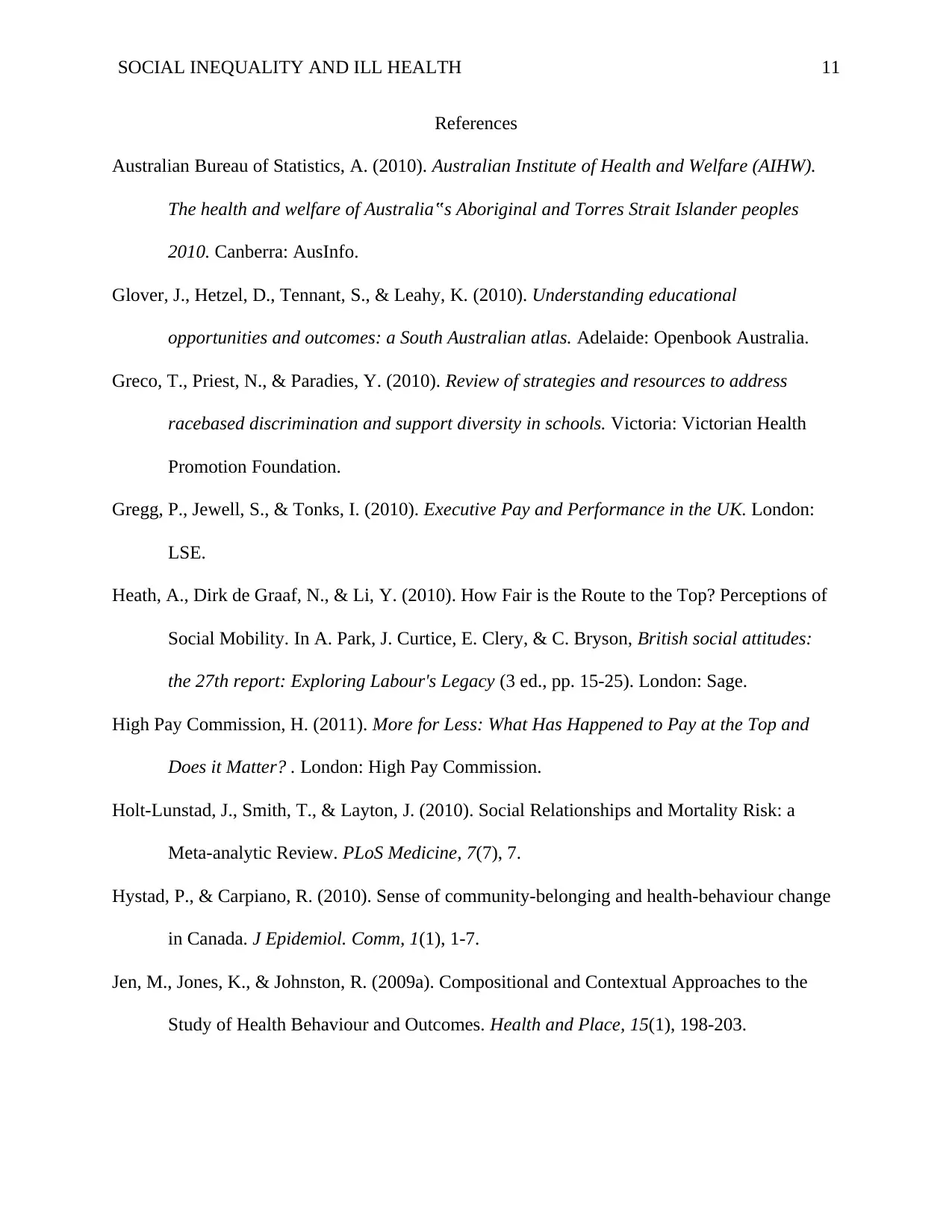
SOCIAL INEQUALITY AND ILL HEALTH 11
References
Australian Bureau of Statistics, A. (2010). Australian Institute of Health and Welfare (AIHW).
The health and welfare of Australia‟s Aboriginal and Torres Strait Islander peoples
2010. Canberra: AusInfo.
Glover, J., Hetzel, D., Tennant, S., & Leahy, K. (2010). Understanding educational
opportunities and outcomes: a South Australian atlas. Adelaide: Openbook Australia.
Greco, T., Priest, N., & Paradies, Y. (2010). Review of strategies and resources to address
racebased discrimination and support diversity in schools. Victoria: Victorian Health
Promotion Foundation.
Gregg, P., Jewell, S., & Tonks, I. (2010). Executive Pay and Performance in the UK. London:
LSE.
Heath, A., Dirk de Graaf, N., & Li, Y. (2010). How Fair is the Route to the Top? Perceptions of
Social Mobility. In A. Park, J. Curtice, E. Clery, & C. Bryson, British social attitudes:
the 27th report: Exploring Labour's Legacy (3 ed., pp. 15-25). London: Sage.
High Pay Commission, H. (2011). More for Less: What Has Happened to Pay at the Top and
Does it Matter? . London: High Pay Commission.
Holt-Lunstad, J., Smith, T., & Layton, J. (2010). Social Relationships and Mortality Risk: a
Meta-analytic Review. PLoS Medicine, 7(7), 7.
Hystad, P., & Carpiano, R. (2010). Sense of community-belonging and health-behaviour change
in Canada. J Epidemiol. Comm, 1(1), 1-7.
Jen, M., Jones, K., & Johnston, R. (2009a). Compositional and Contextual Approaches to the
Study of Health Behaviour and Outcomes. Health and Place, 15(1), 198-203.
References
Australian Bureau of Statistics, A. (2010). Australian Institute of Health and Welfare (AIHW).
The health and welfare of Australia‟s Aboriginal and Torres Strait Islander peoples
2010. Canberra: AusInfo.
Glover, J., Hetzel, D., Tennant, S., & Leahy, K. (2010). Understanding educational
opportunities and outcomes: a South Australian atlas. Adelaide: Openbook Australia.
Greco, T., Priest, N., & Paradies, Y. (2010). Review of strategies and resources to address
racebased discrimination and support diversity in schools. Victoria: Victorian Health
Promotion Foundation.
Gregg, P., Jewell, S., & Tonks, I. (2010). Executive Pay and Performance in the UK. London:
LSE.
Heath, A., Dirk de Graaf, N., & Li, Y. (2010). How Fair is the Route to the Top? Perceptions of
Social Mobility. In A. Park, J. Curtice, E. Clery, & C. Bryson, British social attitudes:
the 27th report: Exploring Labour's Legacy (3 ed., pp. 15-25). London: Sage.
High Pay Commission, H. (2011). More for Less: What Has Happened to Pay at the Top and
Does it Matter? . London: High Pay Commission.
Holt-Lunstad, J., Smith, T., & Layton, J. (2010). Social Relationships and Mortality Risk: a
Meta-analytic Review. PLoS Medicine, 7(7), 7.
Hystad, P., & Carpiano, R. (2010). Sense of community-belonging and health-behaviour change
in Canada. J Epidemiol. Comm, 1(1), 1-7.
Jen, M., Jones, K., & Johnston, R. (2009a). Compositional and Contextual Approaches to the
Study of Health Behaviour and Outcomes. Health and Place, 15(1), 198-203.
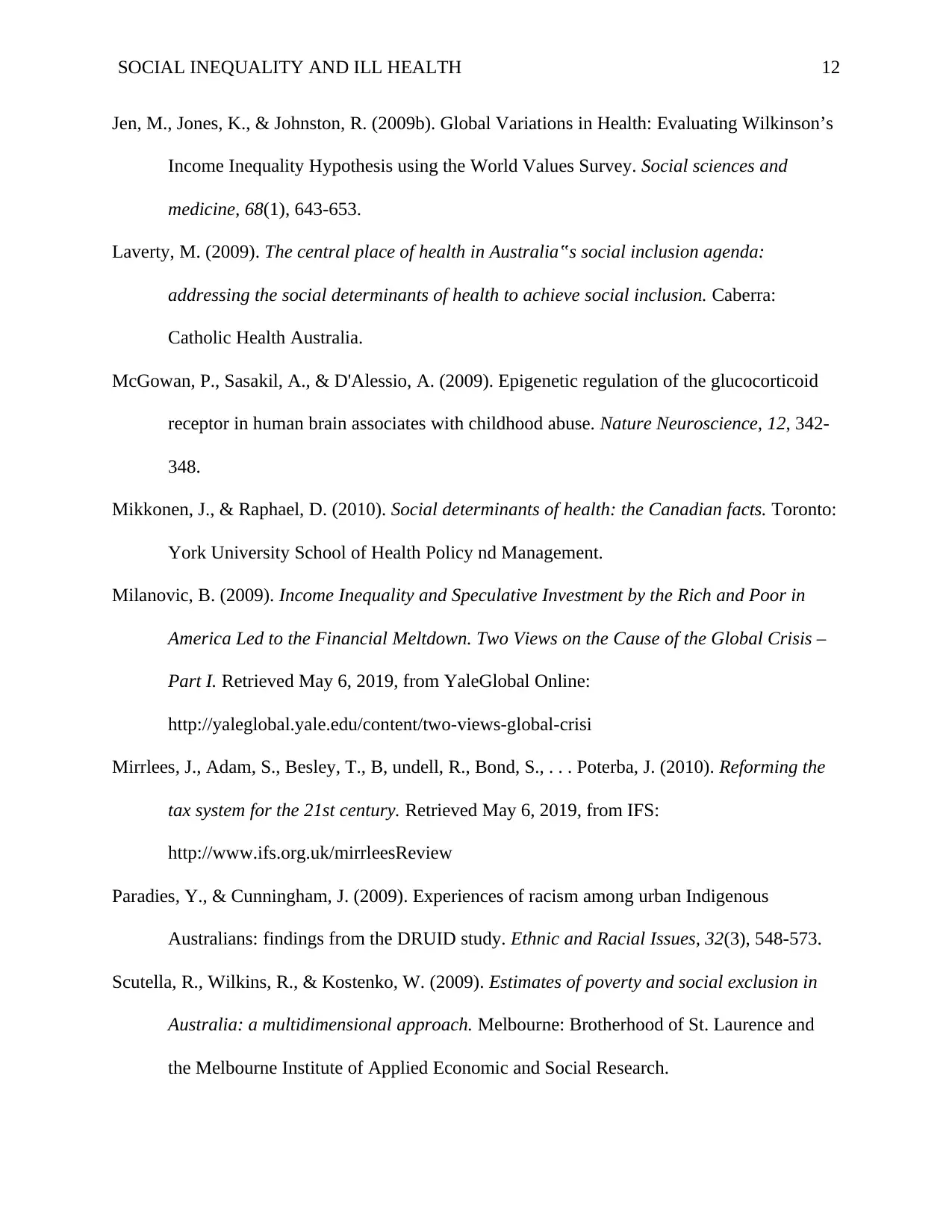
SOCIAL INEQUALITY AND ILL HEALTH 12
Jen, M., Jones, K., & Johnston, R. (2009b). Global Variations in Health: Evaluating Wilkinson’s
Income Inequality Hypothesis using the World Values Survey. Social sciences and
medicine, 68(1), 643-653.
Laverty, M. (2009). The central place of health in Australia‟s social inclusion agenda:
addressing the social determinants of health to achieve social inclusion. Caberra:
Catholic Health Australia.
McGowan, P., Sasakil, A., & D'Alessio, A. (2009). Epigenetic regulation of the glucocorticoid
receptor in human brain associates with childhood abuse. Nature Neuroscience, 12, 342-
348.
Mikkonen, J., & Raphael, D. (2010). Social determinants of health: the Canadian facts. Toronto:
York University School of Health Policy nd Management.
Milanovic, B. (2009). Income Inequality and Speculative Investment by the Rich and Poor in
America Led to the Financial Meltdown. Two Views on the Cause of the Global Crisis –
Part I. Retrieved May 6, 2019, from YaleGlobal Online:
http://yaleglobal.yale.edu/content/two-views-global-crisi
Mirrlees, J., Adam, S., Besley, T., B, undell, R., Bond, S., . . . Poterba, J. (2010). Reforming the
tax system for the 21st century. Retrieved May 6, 2019, from IFS:
http://www.ifs.org.uk/mirrleesReview
Paradies, Y., & Cunningham, J. (2009). Experiences of racism among urban Indigenous
Australians: findings from the DRUID study. Ethnic and Racial Issues, 32(3), 548-573.
Scutella, R., Wilkins, R., & Kostenko, W. (2009). Estimates of poverty and social exclusion in
Australia: a multidimensional approach. Melbourne: Brotherhood of St. Laurence and
the Melbourne Institute of Applied Economic and Social Research.
Jen, M., Jones, K., & Johnston, R. (2009b). Global Variations in Health: Evaluating Wilkinson’s
Income Inequality Hypothesis using the World Values Survey. Social sciences and
medicine, 68(1), 643-653.
Laverty, M. (2009). The central place of health in Australia‟s social inclusion agenda:
addressing the social determinants of health to achieve social inclusion. Caberra:
Catholic Health Australia.
McGowan, P., Sasakil, A., & D'Alessio, A. (2009). Epigenetic regulation of the glucocorticoid
receptor in human brain associates with childhood abuse. Nature Neuroscience, 12, 342-
348.
Mikkonen, J., & Raphael, D. (2010). Social determinants of health: the Canadian facts. Toronto:
York University School of Health Policy nd Management.
Milanovic, B. (2009). Income Inequality and Speculative Investment by the Rich and Poor in
America Led to the Financial Meltdown. Two Views on the Cause of the Global Crisis –
Part I. Retrieved May 6, 2019, from YaleGlobal Online:
http://yaleglobal.yale.edu/content/two-views-global-crisi
Mirrlees, J., Adam, S., Besley, T., B, undell, R., Bond, S., . . . Poterba, J. (2010). Reforming the
tax system for the 21st century. Retrieved May 6, 2019, from IFS:
http://www.ifs.org.uk/mirrleesReview
Paradies, Y., & Cunningham, J. (2009). Experiences of racism among urban Indigenous
Australians: findings from the DRUID study. Ethnic and Racial Issues, 32(3), 548-573.
Scutella, R., Wilkins, R., & Kostenko, W. (2009). Estimates of poverty and social exclusion in
Australia: a multidimensional approach. Melbourne: Brotherhood of St. Laurence and
the Melbourne Institute of Applied Economic and Social Research.
⊘ This is a preview!⊘
Do you want full access?
Subscribe today to unlock all pages.

Trusted by 1+ million students worldwide
1 out of 12
Related Documents
Your All-in-One AI-Powered Toolkit for Academic Success.
+13062052269
info@desklib.com
Available 24*7 on WhatsApp / Email
![[object Object]](/_next/static/media/star-bottom.7253800d.svg)
Unlock your academic potential
Copyright © 2020–2025 A2Z Services. All Rights Reserved. Developed and managed by ZUCOL.




